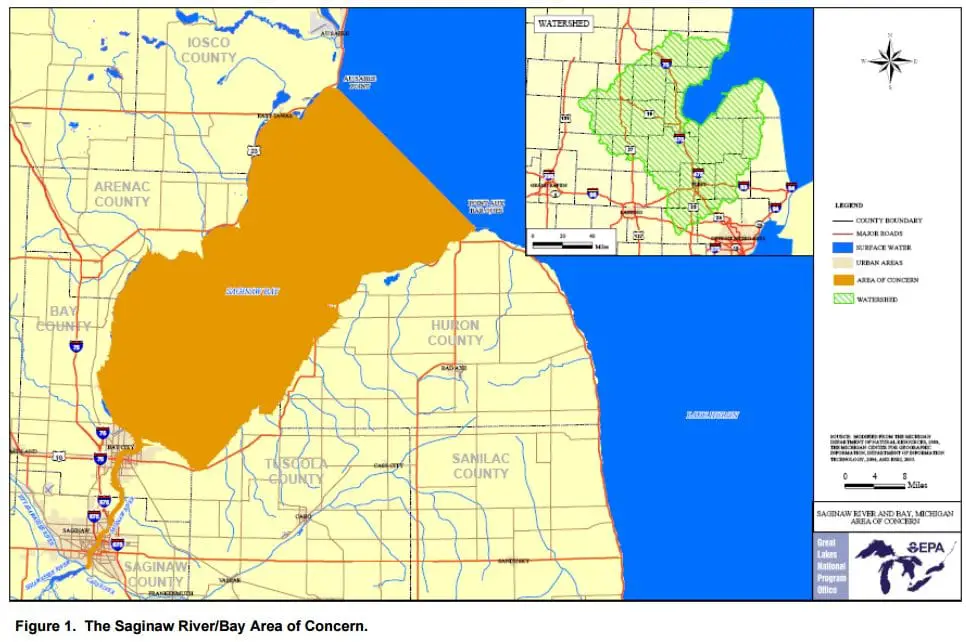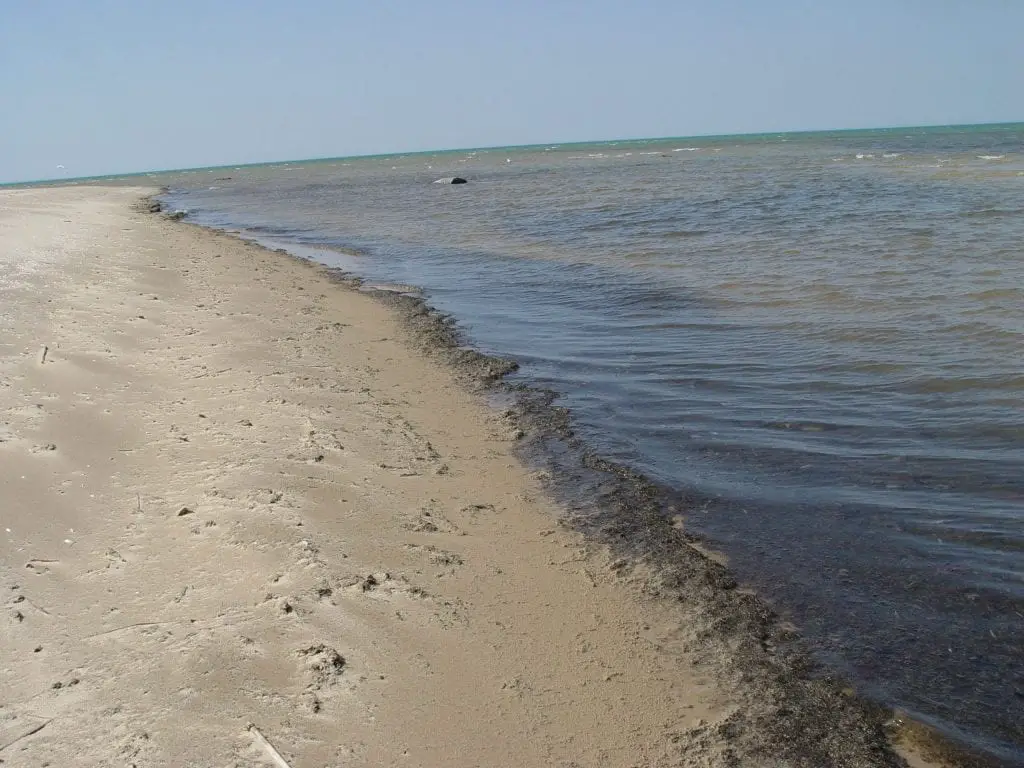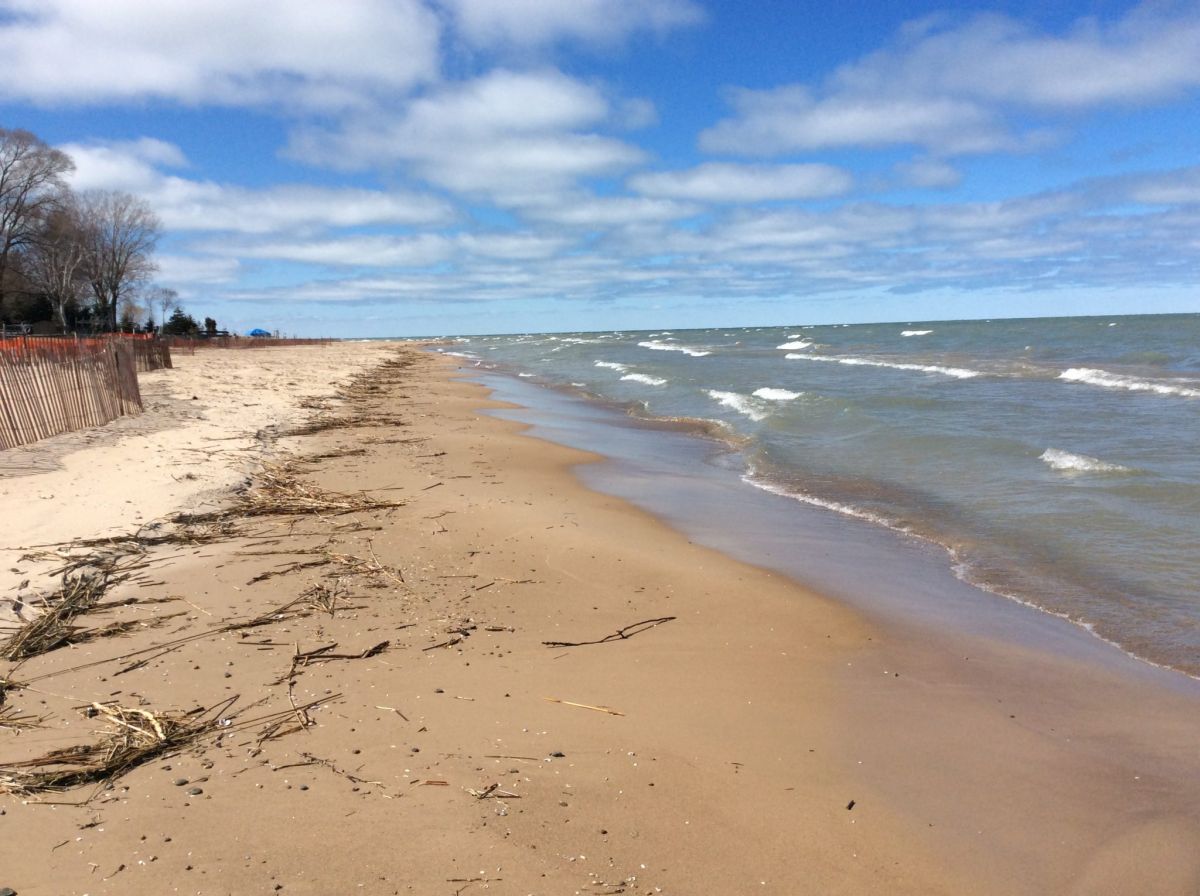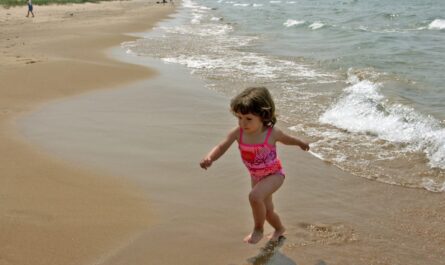
On summer mornings with coffee in hand, I walk down to the beach and gaze out over the vast expanse of water between Port Austin and Tawas. It’s considered an idyllic ecosystem entire of tasty Perch and Walleye. It’s a playground for swimming, sailing, and boating. The sugar sand beaches are where many babies experience their first Great Lakes dunking, and children play and make sandcastles at the water’s edge. Today, I’m not so sure, but I found that the federal government is tracking the progress of Saginaw Bay Pollution.
Table of Contents
Saginaw Bay – An Environmental Disaster
However, back in the era of Big Hair, Members Only jackets and Yuppies, the EPA and the State of Michigan designated the entire region as a potential environmental disaster. The deterioration and pollution were so bad that the label of “Area of Concern” was slapped on the Saginaw Bay in 1987. While progress has been made the designation has not been lifted for 35 years.

While researching another topic, I stumbled on to the DEQ website outlining the problems identified with the Saginaw River and Bay. There are twelve extremely significant Beneficial Use Impairments (BUIs) identified. To achieve delisting as an Area of Concern, each of the BUIs must be identified as solved. In the past 30 years, only three BUIs have been remedied. I had no clue that this serious set of conditions existed. I don’t recall it ever being publicized.
Three Long Decades of Little Progress
The Saginaw River/Bay Area Of Concern was listed due to contaminated sediments, fish consumption advisories, high bacteria, nutrient enrichment (e.g., phosphorus), sedimentation, degraded fisheries, and loss of significant recreational values. Part of the region near the Tittabawassee River was listed as a Superfund site and flows right into the Bay and out to Lake Huron. This listing was in 1988 when the entire Great Lakes watershed was experiencing the same high water levels as we are now in 2017.
Here are the problems identified in the 1980s, all but 3 continue today.
1. Saginaw Bay – Restrictions on fish and wildlife consumption
Dioxin contamination from Tittabawassee River sediments is a current and active source of dioxin contamination to the Saginaw River and Saginaw Bay.
2. Tainting of fish and wildlife flavor – REMOVED
Chemical odors and tastes associated with fish caught in the Tittabawassee River and the Saginaw River/Bay AOC were frequently reported from the 1940s through the 1970s. This issue has been deemed solved in 2008. Today, there are record levels of walleye in Saginaw Bay.
3. Bird or animal deformities or reproductive problems
Terns, herons, and eagles that were injured due to contaminants and linked to death (Caspian terns), malfunctions in reproduction (Caspian terns, common terns, bald eagles), and physical deformations (black-crowned night herons, Caspian terns, common terns)
4. Degradation of Benthos
Degradation of the benthos of Saginaw Bay as an impaired use because the benthic community structure in the bay is significantly degraded from that which occurs in unpolluted sites elsewhere in the Great Lakes. Specifically, the mayfly, once abundant in Saginaw Bay and an important component of the fish forage base, is currently only rarely found in the bay. Researchers believe that high oxygen demand created by the increased decomposition of organic debris in the sediments has decreased dissolved oxygen levels below that needed to support mayflies and other pollution-intolerant species.
5. Restrictions on Dredging Activities
Historically, sediments dredged from parts of the navigation channel in the Saginaw River and Saginaw Bay require confined disposal because of elevated levels of pollutants, including PCBs, several metals (e.g., mercury), nutrients, and oil and grease.

6. Eutrophication (aka High Fertilizer and Poop Levels) or undesirable algae
Nuisance organic “muck” debris, composed mainly of Cladophora (a benthic alga), continues to wash ashore along Saginaw Bay (Saginaw Bay Science Committee Pathogen Work Group, 2007). These conditions are thought to be caused, in part, by the cultural eutrophication of Saginaw Bay. In 2012 Thumbwind posted an article that testing this “muck” showed it contained bovine and human fecal material. “Poop”! We were swimming in poop.
7. Restrictions on drinking water consumption or taste and odor problems – REMOVED
The drinking water use impairment was identified initially primarily due to significant taste and odor problems during the 1970s that were linked to excessive blue-green algal (i.e., cyanobacteria) blooms, which had caused some of the drinking water intake in the bay to exceed federal threshold odor standards. It was declared solved in 2008.
8. Beach closings
Local health departments periodically issue public advisories following storm events, warning against body contact with the Saginaw River and Saginaw Bay because of elevated levels of pathogens (E. coli) resulting from combined sewer overflows. Just about every beach in the Upper Thumb has been closed at one time or another due to high E. coli levels.
9. Degradation of aesthetics
Like the Eutrophication (aka High Fertilizer and Poop Levels) or Undesirable Algae use impairment, increased biological productivity in Saginaw Bay increased the organic debris or “muck” washing up on the shoreline of Saginaw Bay. The debris comprises decomposing algae, aquatic plants, and small invertebrate animals. The smell and unsightliness of this beach debris prompted citizen complaints and concern about pollution entering the bay. Because of these complaints, aesthetics was listed as a use impairment for Saginaw Bay.
10. Degradation of phyto- or zooplankton populations
The lack of zooplankton grazing in Saginaw Bay was believed to be due, in part, to a greater abundance of large, unpalatable filamentous blue-green and green algae in Saginaw Bay. Believed to be caused by the cultural eutrophication of Saginaw Bay, which was brought about by excessive nutrient loading. Phosphorus appeared to be the key factor responsible for excessive growth.
11. Degradation of fish and wildlife populations & Loss of fish and wildlife habitat
Habitat degradation includes the loss of coastal marsh areas, the sedimentation of fish spawning reefs in Saginaw Bay, and numerous impacts from exotic species (e.g. goby, ruffe, and zebra mussels). This habitat loss and degradation has impaired the reproductive success and growth of numerous aquatic and wildlife species. Deemed solved in 2014.
We have reached out to the Michigan DEQ to get an update on the progress of Saginaw Bay pollution and the River/Bay’s AOC. We are also interested in if PFAS in Saginaw Bay. We will update if there is a response about the Saginaw Bay water pollution.
Students & Educators: If you are using this article as part of your on-line class or as a lesson plan research source we would appreciate knowing about it and would like your suggestions for helpful topics we can cover in the future. Contact us on the Thumbwind About Page.
Related Reading for Saginaw Bay Pollution
- Algae Bloom in Michigan’s Saginaw Bay Seen from Space
- Michigan Climate Change Measurable in Huron County
- Saginaw Bay Muck is Nothing Less than Poop
- Bay Port Commercial Fishing District
- We ask a DNR Fish Biologist; What Happened to All the Yellow Perch in Saginaw Bay?
- Prepping Your Boat For The Sailing Season On Lake Huron
- Executive Order Bans Travel Between Michigan Residences
Map provided by EPA. All other photos (c) ThumbWind






So sad that we have neglected our responsibility to nature.
Well done, well defined. Have put up with this mess for decades & who admits accountability? No one! Share this, everyone!